
The Casuarinaceae are a family of dicotyledonous flowering plants placed in the order Fagales, consisting of four genera and 91 species of trees and shrubs native to eastern Africa, Australia, Southeast Asia, Malesia, Papuasia, and the Pacific Islands. At one time, all species were placed in the genus Casuarina. Lawrence Alexander Sidney Johnson separated out many of those species and renamed them into the new genera of Gymnostoma in 1980 and 1982, Allocasuarina in 1982, and Ceuthostoma in 1988, with some additional formal descriptions of new species in each other genus. At the time, it was somewhat controversial. The monophyly of these genera was later supported in a 2003 genetics study of the family. In the Wettstein system, this family was the only one placed in the order Verticillatae. Likewise, in the Engler, Cronquist, and Kubitzki systems, the Casuarinaceae were the only family placed in the order Casuarinales.
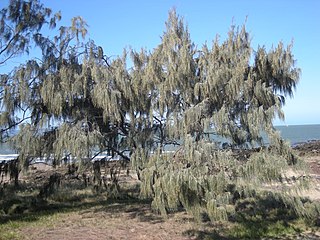
Casuarina equisetifolia, the Australian pine tree or whistling pine tree, is a she-oak species of the genus Casuarina. The native range extends throughout Southeast Asia, Northern Australia and the Pacific Islands; including Thailand, Myanmar, Vietnam, Malaysia, Singapore, Brunei, Indonesia, East Timor, and the Philippines, east to Papua New Guinea, French Polynesia, New Caledonia, and Vanuatu, and south to Australia. Populations are also found in Madagascar, but it is doubtful if this is within the native range of the species. The species has been introduced to the Southern United States and West Africa. It is an invasive species in Florida, South Africa, India and Brazil.

Casuarina is a genus of 17 tree species in the family Casuarinaceae, native to Australia, the Indian subcontinent, southeast Asia, islands of the western Pacific Ocean, and eastern Africa. It was once treated as the sole genus in the family, but has been split into four genera.

Dysoxylum is a flowering plant genus of trees and shrubs from the mahogany family, Meliaceae.
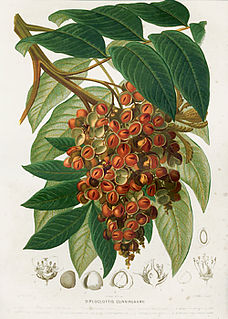
Diploglottis is a genus of 10 species of trees known to science, constituting part of the plant family Sapindaceae. They grow naturally in rainforests and margins of adjoining humid forests in eastern Australia and New Guinea. Some species are known as native tamarind or small-leaved tamarind; they have no direct relationship with the true tamarind.
Triunia is a genus of medium to tall shrubs or small trees found as understorey plants in rainforests of eastern Australia. Members of the plant family Proteaceae, they are notable for their poisonous fleshy fruits or drupes. Only one species, T. youngiana, is commonly seen in cultivation.
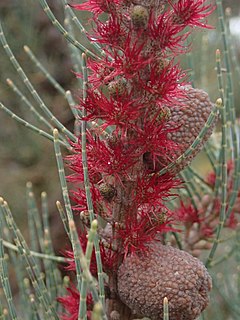
Allocasuarina humilis, commonly known as the dwarf sheoak or dwarf casuarina, is a woody shrub of the family Casuarinaceae endemic to the south-west of Western Australia.
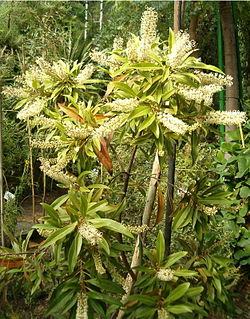
Buckinghamia is a genus of only two known species of trees, belonging to the plant family Proteaceae. They are endemic to the rainforests of the wet tropics region of north eastern Queensland, Australia. The ivory curl flower, B. celsissima, is the well known, popular and widely cultivated species in gardens and parks, in eastern and southern mainland Australia, and additionally as street trees north from about Brisbane. The second species, B. ferruginiflora, was only recently described in 1988.
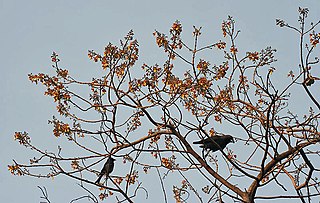
Gmelina is a genus of plants in the family Lamiaceae. It consists of about 35 species in Australia, New Guinea, New Caledonia, Southeast Asia, India and a few in Africa. Some species such as G. arborea have been planted and/or become naturalised in India, Africa and Australia. It was named by Carl Linnaeus in honour of botanist Johann Georg Gmelin.

Helicia is a genus of 110 species of trees and shrubs, constituting part of the plant family Proteaceae. They grow naturally in rainforests throughout tropical South and Southeast Asia, including India, Sri Lanka, Indochina, Peninsular Malaysia to New Guinea and as far south as New South Wales.
Hicksbeachia pilosa is a small tree in the family Proteaceae. This rare species is endemic to the rainforests of the wet tropics region of northeastern Queensland, Australia. It was first described in 1988 by Australian botanist Peter H. Weston, after a collection by Garry Sankowsky and Peter Hind in 1986 at Bobbin Bobbin Falls in North Queensland. Its specific name is the Latin adjective pilosus "hairy".
Corymbia papuana, commonly known as ghost gum, is a species of evergreen tree native to New Guinea, some Torres Strait Islands and the northern part of the Cape York Peninsula in Australia. It has smooth whitish bark, lance-shaped adult leaves, flower buds in groups of three or seven, creamy white flowers and barrel-shaped or urn-shaped fruit.
Finschia is a genus of three recognised species of large trees, constituting part of the plant family Proteaceae. They grow naturally in New Guinea and its surrounding region, in habitats from luxuriant lowland rainforests to steep highland forests.

Allocasuarina inophloia, also known as woolly oak, or stringybark she-oak, is a shrub or small tree of the she-oak family Casuarinaceae endemic to inland New South Wales and Queensland. The hairy bark is an unusual feature.

Gymnostoma is a genus of about eighteen species of trees and shrubs, constituting one of the four genera of the plant family Casuarinaceae. The species grow naturally in the tropics, including at high altitudes having temperate climates, in forests in the region of the western Pacific ocean and Malesia. In New Caledonia, published botanical science describes eight species found growing naturally, which botanists have not found anywhere else (endemics). Additional species have been found across Burma, Sumatra, Borneo, the Philippines, Sulawesi, Ambon Island, the Moluccas, New Guinea, the Bismarck Archipelago, the Solomon Islands, and one endemic species each in Fiji and the Wet Tropics of Queensland, Australia.
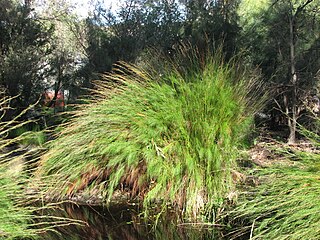
Baloskion tetraphyllum is a rush-like plant in the family Restionaceae. Common names include tassel rope-rush, plume rush and Australian reed.
Hollandaea is a genus of four species known to science, of Australian rainforest trees, constituting part of the plant family Proteaceae.

Placospermum is a genus of a single species of large trees, constituting part of the plant family Proteaceae. The species Placospermum coriaceum is endemic to the rainforests of the wet tropics region of northeastern Queensland, Australia. Common names include rose silky oak and plate-seeded oak.
Dictyoneura is a genus of 2–3 species of rainforest trees known to science, constituting part of the plant family Sapindaceae.
Corymbia novoguinensis is a species of tree that is native to New Guinea, some Torres Strait Island and the Cape York Peninsula. It has rough bark on the trunk and branches, lance-shaped adult leaves, flower buds in groups of seven, creamy white flowers and urn-shaped to barrel-shaped fruit.












